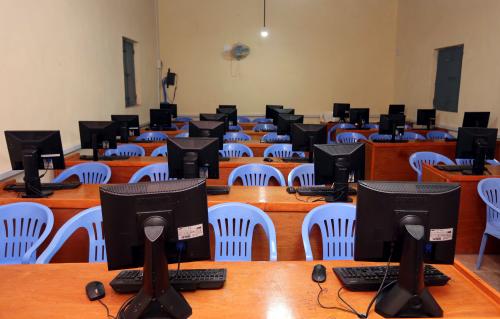Providing young people with access to quality computer science (CS) education is increasingly seen as an urgent priority for public school systems in the U.S. and around the globe. And it’s for good reason: Expanding CS education is expected to directly benefit students, promote sustainable economic growth, and help close historical gaps in technology fields.
The past decade has been an active period of policy expansion in CS education across states and growing student engagement in CS courses. Yet, little is known about how policies may have influenced student engagement in CS. Today, we released a new report that offers a first look at this relationship by exploring recent policy changes and student participation and passing outcomes on the Advanced Placement Computer Science (AP CS) exams. This post summarizes the five key lessons that emerged from our analysis.
1. We observe sharp, coinciding increases in both state adoption of CS education policies and overall participation in AP CS exams.
A team of organizations has been publishing the annual State of Computer Science Education report since 2017, and in the few years of policy tracking through 2021 the reports document a remarkable transformation of the policy landscape across states. For example, only one state—Arkansas—had adopted at least seven of nine key CS education policies when the series began in 2017, but another 23 states had joined them by 2021.
Simultaneously, student participation in AP CS exams has grown rapidly. In 2012, fewer than 25,000 exams were taken in AP CS by public school students, but this number surged to more than 150,000 exams by 2020—more than 500% growth.
2. AP CS participation rates for all student subgroups have also increased, with representation gaps between student groups narrowing.
Technology fields have long been dominated by white, Asian, and male students, though many CS education initiatives now aim to reverse these gaps. Our analysis showed encouraging upticks in participation among all student subgroups, with historically underrepresented groups—Black, Latino, and female students—making progress towards parity, even if gaps persist.
3. Narrowing participation gaps have been primarily driven by the introduction of a new AP CS exam (CS Principles), with gaps changing little since then.
Much of this growth in participation among underrepresented groups was associated with the introduction of a new AP CS exam (AP Computer Science Principles) in 2017 designed to test students on more foundational CS material, compared to the more established AP CS A exam. This new course and exam offering has attracted a significantly more diverse group of test-takers, but the increase in the proportion of exams taken by underrepresented racial and ethnic groups has slowed in recent years.
4. Passing rates on AP CS exams have modestly increased for underrepresented student groups during this period, resulting in slightly narrower passing gaps.
Underrepresented students are not only more likely to participate in AP CS over time, but also more likely to pass AP CS exams. Since 2012, passing gaps have narrowed by race and sex on both AP CS exams; a remarkable finding given the surge in participation during this same period.
5. AP CS student participation overall is associated with increased CS policy adoption, though participation gaps between over- and underrepresented groups appear to be uncorrelated with recent policy adoptions.
We find evidence that adopting CS education policies stimulates broader CS participation in states. Specifically, policies promoting CS funding, requiring high schools to offer CS, and having state colleges count CS classes as STEM classes show the highest associated gains in student participation. Yet, we find little evidence to believe that these recent policy changes have helped to narrow the participation gaps between student subgroups.
Computing and technology will be integral parts of the economic and social future awaiting today’s schoolchildren. Providing access to high-quality CS education will be key in ensuring that all students can meet that future head on.








Commentary
Computer science education policies helping to stimulate broader participation
April 11, 2022